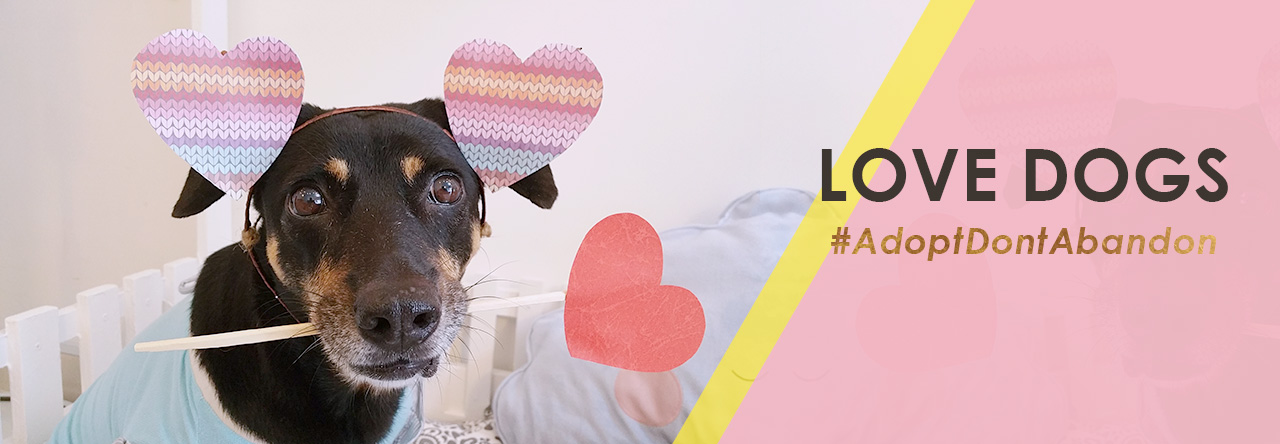kid at the vet: is she a doberman?
me: no, she’s just a mongrel
Maybe, I’m habitually self-effacing and sometimes I discount my dog too much… I was thinking I need to remove “just” from my answer. Anyway, the last time I introduced my dog as a rescued dog, my friend thought the dog goes around rescuing things haha~ so I’ll just stick to “she’s a mongrel.”
But I love the idea of describing the dog’s personality. Morgan from Temporary Home, Permanent Love‘s new post on rescued mutts tries to introduce particular dogs not by breed but by their personality and character traits. And since Donna is a mongrel, I thought I’ll writing about Donna in her format.

Donna: 50% exuberant, 50% tamchiakgui, 30% kiasu, 30% kaypoh, 20% potential disaster, 20% suspicious, 10% loving and 100% patient buddy for dog idiots.
*tamchiakgui = greedy ghost, used to describe someone with a love of food
* kiasu = afraid to lose out
* kaypoh = busybody, tries be in the know or have a paw in everything
Donna struck us as quintessentially Singaporean in her kiasu and kaypoh ways.
How kiasu is Donna?
She likes to get a head start when we play fetch. She won’t sit and wait for you to throw the toy. No, she must already run for the toy when you haven’t even thrown it. If she were in a race, she’ll be the athlete that gets disqualified for false starts.
And when it comes to being kaypoh, Donna is quite the busybody. She is “big brother”. She must needs keep an eye on everything. Mr P in the room and me in the living room? No problem she will be right smack at a point where she can see me and the bedroom door for when he comes out. Donna supervises me doing chores. She tries to inspect our food. And now and then, she’ll try to suss out unsuspecting strangers too, some not too happy about her sniffing them :/
I had briefly thought about teaching her “don’t kaypoh” every time she make to sniff some stranger but I haven’t really done it. So yes, she is essentially still a monolingual dog.


Napping and surveillance. Not mutually exclusive.
And food, what dog doesn’t love food? Stalk the kitchen? Yes. Sport the saddest soulful eyes for as long as it takes? Yes. Yes. Yes. I always thought saliva dripping out of the mouths of cartoon characters and visibly plopping on the floor was nothing more than overly-dramatic caricature. Doesn’t happen in real life. My dog showed me how wrong I was. :P

I’m not too sure how tamchiakgui came into popular use. Perhaps our ancestors think all ghosts are greedy, hence all the food offerings on top of the paper burning during Chingming. Now that I think about it, people do append the word gui (ghost) to the back of the adjective so kaypohgui works as well. Maybe our ancestors just had a fixation with ghosts in general, haha~
Anyway just so you know, 50% exuberant, 50% tamchiakgui, 30% kiasu, 30% kaypoh, 20% potential disaster, 20% suspicious, 10% loving and 100% patient buddy for dog idiots, may not all sound like all awesomely amazing traits but to us they can be pretty adorable at times and if that’s who our dog is, that’s who our dog is.
But that makes the introduction kind of wordy because a dog is not just a dog is she? So I’ll keep to “She is a local mongrel” for now.
Tamchiakgui, kiasu and kaypoh are words in the Teochew and Hokkien dialects. Use them with English with a sprinkle of Malay here and a smatter of Chinese there in Singapore and it becomes Singlish. Short, clipped sentences will do. We prefer efficiency in our language unless we’re writing it.






















